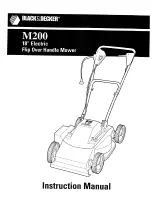
Not for
Reproduction
19
Mulching
Mulching consists of a mower deck which cuts and re-cuts
clippings into tiny particles and which then blows them down
INTO the lawn. These tiny particles decompose rapidly
into by-products your lawn can use. UNDER PROPER
CONDITIONS, your mulching mower will virtually eliminate
noticeable clippings on the lawn surface.
Note:
When mulching under heavy cutting conditions, a
rumbling sound may be present and is normal.
Mulching Requires EXCELLENT Mowing Conditions:
Mulching mowers cannot function properly if the grass is wet,
or if the grass is simply to high to cut. Even more than normal
mowing, mulching requires that the grass be dry and the
appropriate amount is cut.
Do not use the mower as a mulching mower during the
first two or three mowings in the spring. The long grass
blades, quick growth, and often wetter conditions are more
suitable for broadcasting (side-discharging) or grass bagging
operation.
Engine Speed & Ground Speed for Mulching:
Use full engine throttle matched with a slow ground speed so
that clippings will be finely cut. Ground speed while mulching
should be HALF of the speed that would be used when
broadcasting (side discharging) under similar conditions.
Since mulching requires more horsepower than broadcasting,
using a slower ground speed is vitally important for proper
mulching operation.
How Much Grass to Mulch:
The best mulching action typically results from cutting only
the top ½ inch to 3/4 inch of grass blade. This provides
short clippings which decompose properly (much more
quickly than longer clippings). The ideal cutting height will
vary with climate, time of year, and quality of your lawn. We
recommend that you experiment with both the cutting height
and ground speed until you achieve the best cut. Start with
a high cutting height and using progressively lower settings
until you find a cutting height that is matched to your mowing
conditions and preferences.
Pushing the Rider By Hand
WARNING
Unsafe Operation Hazard.
DO NOT disengage the transmissions and coast down
slopes. DO NOT use the transaxle release levers to
disengage the transmissions unless machine motion can be
controlled and engine is off.
NOTICE
Do not tow rider.
Towing the unit will cause transmission
damage. Do not use another vehicle to push or pull this unit.
1. Disengage the PTO, engage the parking brake, turn the
ignition switch to OFF, and remove the ignition key.
2. Locate the transmission release levers (A, Figure 17)
on the rear of the machine beneath the bumper. There
is one transmission release lever on each transmission.
The transmission release levers open and close the
transmission bypass valves.
17
3. To open the transmission bypass valve (bypass position)
(B), pull the transmission release lever out towards the
rear of the machine and then towards the center of the
machine. Repeat this process for the other side of the
unit.
4. Disengage the parking brake. The rider can now be
pushed by hand.
5. After moving the machine, close the bypass valve
(run position) (C) by pulling out towards the side of the
machine and then push forward. Repeat this process for
the other side of the unit.
Note:
Both transmission release levers must be in the same
position.
Towed Equipment
Secure the trailer with an appropriately sized clevis pin (A,
Figure 18) and clip (B). See
Operator Safety
for additional
safety information regarding trailers and towing.
Содержание 500S Series
Страница 1: ...N o t f o r R e p r o d u c t i o n...
Страница 36: ...N o t f o r R e p r o d u c t i o n...
















































